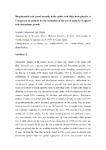Mostrar o rexistro simple do ítem
Morphometric and gonad maturity in the spider crab "Maja brahcydactyla". A comparison of methods for the estimation of the size at maturity in species with determinate growth
| dc.contributor.author | Corgos López-Prado, Antonio | |
| dc.date.accessioned | 2005-10-28T11:12:47Z | |
| dc.date.available | 2005-10-28T11:12:47Z | |
| dc.date.issued | 2005 | |
| dc.identifier.uri | http://hdl.handle.net/2183/129 | |
| dc.description.abstract | [Abstract] Ontogenetic changes in the relative growth of males and females of the spider crab Maja brachydactyla, a species with terminal moult and determinate growth, were analyzed and related to their reproductive (maturity) status. Sampling was carried out in the Ría de A Coruña (NW Spain) from December 1997 to November 1999. A combination of principal component analysis of morphometric variables, nonhierarchical K-means cluster and discriminant analysis allowed to differentiate two morphometric groups of males defined as juvenile and adult phases and develop statistical methods to assign maturity status to individual crabs. A significant change in allometry of cheliped size was detected in juvenile males with a breakpoint at 96.2 mm carapace length (CL), separating the inmature and adolescent phases. Histological analysis of males showed that more than 60% of morphometrically juveniles and 100% of morphometrically adults presented spermatophores in the gonad. Size at gonad maturity in males (estimated as CL50) was 96.2 mm CL. Size at morphometric maturity was estimated comparing two methodologies: the size at 50% maturity (CL50) and the median size of adult cohorts. For the whole sampling period, two adult-year classes, CL50 was estimated to be 136.5 mm for males and 130.3 mm for females, while median size of adult cohorts for the same period was estimated to be 139.9 mm for males and 148.7 mm for females. In all cases the size at maturity obtained from the median of the cohort was greater than the one resulting from the CL50 method with differences of over 20 mm, showing the bias that methods based in CL50 could cause in animals with determinate growth. Due the spatial segregation of adults and juveniles and the availability of morphological and morphometrical methods to estimate the maturity status of any crab, we propose a combination of spatial closures and direct protection of juvenile habitat as management strategies alternative to minimum landing sizes | es_ES |
| dc.description.sponsorship | Xunta de Galicia; XUGA10301B97 | |
| dc.description.sponsorship | Ministerio de Ciencia y Tecnología; REN2000-0446MAR | |
| dc.format.mimetype | application/pdf | |
| dc.format.mimetype | text/plain | |
| dc.language.iso | spa | es_ES |
| dc.title | Morphometric and gonad maturity in the spider crab "Maja brahcydactyla". A comparison of methods for the estimation of the size at maturity in species with determinate growth | es_ES |
| dc.type | info:eu-repo/semantics/workingPaper | es_ES |
| dc.rights.access | info:eu-repo/semantics/openAccess | es_ES |






